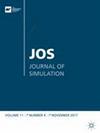A generalised SEIRD model with implicit social distancing mechanism: A Bayesian approach for the identification of the spread of COVID-19 with applications in Brazil and Rio de Janeiro state
IF 1.7
4区 工程技术
Q4 COMPUTER SCIENCE, INTERDISCIPLINARY APPLICATIONS
引用次数: 4
Abstract
ABSTRACT We develop a generalized Susceptible--Exposed--Infected--Removed--Dead (SEIRD) model considering social distancing measures to describe the COVID-19 spread in Brazil. We assume uncertain scenarios with limited testing capacity, lack of reliable data, under-reporting of cases, and restricted testing policy. A Bayesian framework is proposed for the identification of model parameters and uncertainty quantification of the model outcomes. We identify through sensitivity analysis (SA) that the model parameter related to social distancing measures is one of the most influential. Different relaxation strategies of social distancing measures are then investigated to determine which are viable and less hazardous to the population. The scenario of abrupt social distancing relaxation implemented after the peak of positively diagnosed cases can prolong the epidemic. A more severe scenario occurs if a social distancing relaxation policy is implemented prior to the evidence of epidemiological control, indicating the importance of the appropriate choice of when to start the relaxation.具有隐式社交距离机制的广义SEIRD模型:识别新冠肺炎传播的贝叶斯方法及其在巴西和里约热内卢州的应用
我们建立了一个广义的易感-暴露-感染-移除-死亡(SEIRD)模型,考虑社会距离措施来描述COVID-19在巴西的传播。我们假设不确定的情况下,检测能力有限,缺乏可靠的数据,病例报告不足,检测政策受限。提出了一个贝叶斯框架,用于模型参数的识别和模型结果的不确定性量化。通过敏感性分析(SA),我们发现与社会距离措施相关的模型参数是最具影响力的参数之一。然后研究了不同的放松社会距离措施的策略,以确定哪些是可行的,对人群的危害较小。在确诊病例高峰后突然放松社交距离的情景可能会延长疫情。如果在流行病学控制证据出现之前实施放松社会距离政策,则会出现更严重的情况,这表明适当选择何时开始放松政策的重要性。
本文章由计算机程序翻译,如有差异,请以英文原文为准。
求助全文
约1分钟内获得全文
求助全文
来源期刊

Journal of Simulation
COMPUTER SCIENCE, INTERDISCIPLINARY APPLICATIONS-OPERATIONS RESEARCH & MANAGEMENT SCIENCE
CiteScore
5.70
自引率
16.00%
发文量
42
期刊介绍:
Journal of Simulation (JOS) aims to publish both articles and technical notes from researchers and practitioners active in the field of simulation. In JOS, the field of simulation includes the techniques, tools, methods and technologies of the application and the use of discrete-event simulation, agent-based modelling and system dynamics.
 求助内容:
求助内容: 应助结果提醒方式:
应助结果提醒方式:


